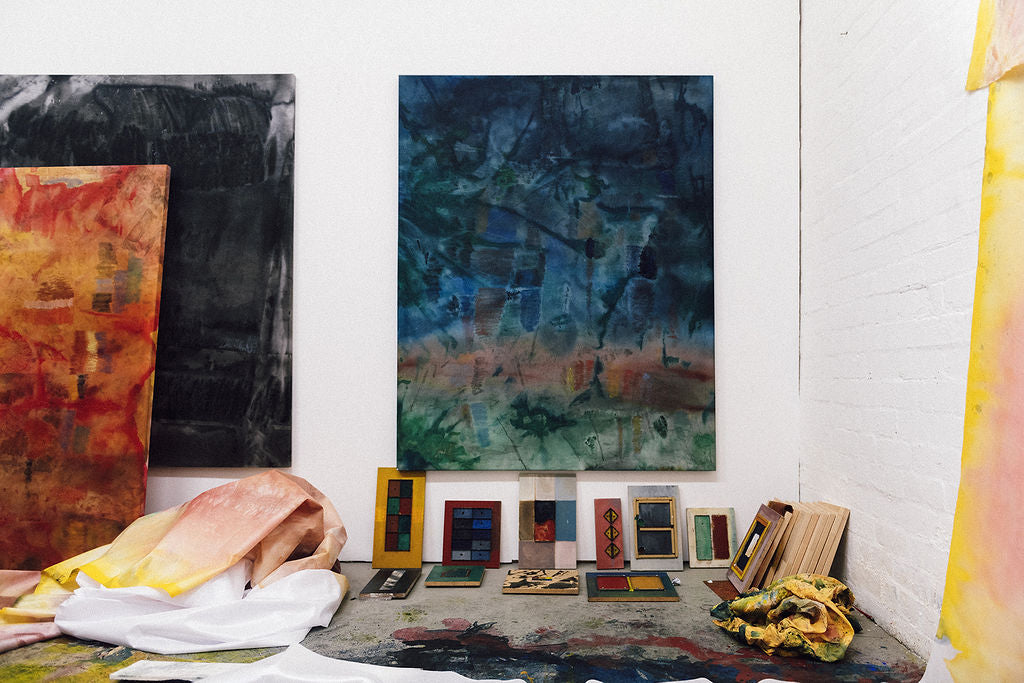Art of Choice: Matt Arbuckle’s Explorations into Abstraction Continue to Push the Genre
Matt Arbuckle paints abstract works whose various elements come together while in process. Born in New Zealand and now based in Melbourne, Australia, Arbuckle poses visual questions through scale, format, composition, color, and mark-making. Using a specific, multi-step process to connect material to medium, Arbuckle’s paintings evoke a range of deeply felt emotions. Arbuckle is represented by Parlour Projects Gallery.
Tell us a little bit about yourself. Where are you from and when did art first enter your life?
I am a painter from New Zealand, I live and work in Melbourne, Australia. Art entered my life relatively late compared to my contemporaries. I think I came to art in an attempt to avoid other routes. I do recall a time in high school when I broke my writing hand. I was forced to complete the rest of the year with the other and I started using different tools and objects to push paint around. I do remember this opening up the language of painting and it helped me to see art in a completely different light. This epiphany did not extent to any other subjects. I think in this way, painting found me first, and then I found painting and made a conscious choice to pursue it.
What themes are you exploring in your work?
My paintings withhold and represent landscapes that are conceptualised through their very making. Landscapes, or escapes as I tend to see them, emerge through introspection. The scapes that are created deviate from specificity of location, yet remain intimate expressions of selfhood, exploring the human experience. They recall moments in space and time, of togetherness and solitude, charting memory to create blueprints of the mind, of emotion and of place. Through the careful manipulation of the fundamentals of abstract painting – scale, format, composition, colour, mark-making, the paintings have evolved into a format of visual questions. These questions are often rhetorical, to evoke thought. For example, is possible to imbue an abstract painted surface with complex information or meaning? Can an abstract painted surface create an emotional narrative?
What is your process like? How does a work begin and end for you?
My paintings go through a few stages before I decide they are worthy of stretching. I collect various fabrics and explore how they take to different consistencies and recipes of pigment, water and binder. In recent works I use a repeated process of submerging semi-transparent knitted polyester voile or silk into a liquified acrylic pigment solution. The material is then heaped and folded on the ground or draped over objects such as fence posts and rocks allowing it to dry. The inks pool and swell with how the fabric falls on the many surfaces that are on the ground. They stick to the surfaces underneath the fabric. Once dry they are pulled away to make various impressions on the fabric (and my studio floor). The pigment retained creates indistinct forms, images of the various drying states and what was underneath are revealed. I then stretch the material and respond to the forms left behind with oil stick using formal structures of scapes. Sometimes, post working a surface, I will pair different materials next to each other within a frame, creating an interesting context to the scape.
Has your work always taken on an abstract nature?
Yes, more or less, although I don’t think of my work as pure abstraction. The process of submerging fabrics perhaps but then the reaction to that process is a calculated response. There is control of visual language/ devices that come to play just as painting a figure. Sure, I am not a figurative painter, but my work has always held formal structures that talk to landscapes and hold narratives.
Who are some artists that most inspire your practice?
Generally I am most inspired by an artist discipline. I am really intrigued in how one maintains a practice and navigates their making journey, and the shifts that can occur over time. In Australia I love following the work of Janet Burchill and Jennifer McCamley as well as Archie Moore, Diena Georgetti, Danea Valenza and Oscar Perry. In New Zealand, Richard Frater, Julian Hooper and Emma Fitts are artists who I am inspired by. American artists Barnett Newman and Sam Gillam have been influential to my practice. If I could go back to the start of the 20th century, I would love to have a long lunch with French painter Jean Édouard Vuillard. Maybe even a lazy indoor/outdoor plain air session.
What are the art scenes in Australia and New Zealand like?
I’d say they are very strong. Australia and New Zealand contrast politically, economically, and culturally, which I think certainly influences the art scenes in each country. For example, I believe New Zealand’s art scene is heavily influenced the Pacifica, where this influence is less present in Australia. A shared dialogue does exist between both country’s art scenes; there seems to be a cross pollination between Australian and New Zealand artists, galleries and institutions. Physically, Australia and New Zealand are oceans away from away from the larger art scenes in Europe and America, both physically and metaphorically. This perhaps is a vantage point. It has fostered a challenging community of independent thinkers and makers, culminating in a vibrancy across the creative disciplines of visual, music, and performance arts.
What’s next for you?
I am currently working on an exhibition which opens early next year at Two Rooms, Auckland, New Zealand and later in the year I have a show with Parlour Projects also in New Zealand.
At the end of every interview, we like to ask the artist to recommend a friend whose work you love for us to interview next. Who would you suggest?
Basia Goszczynska



